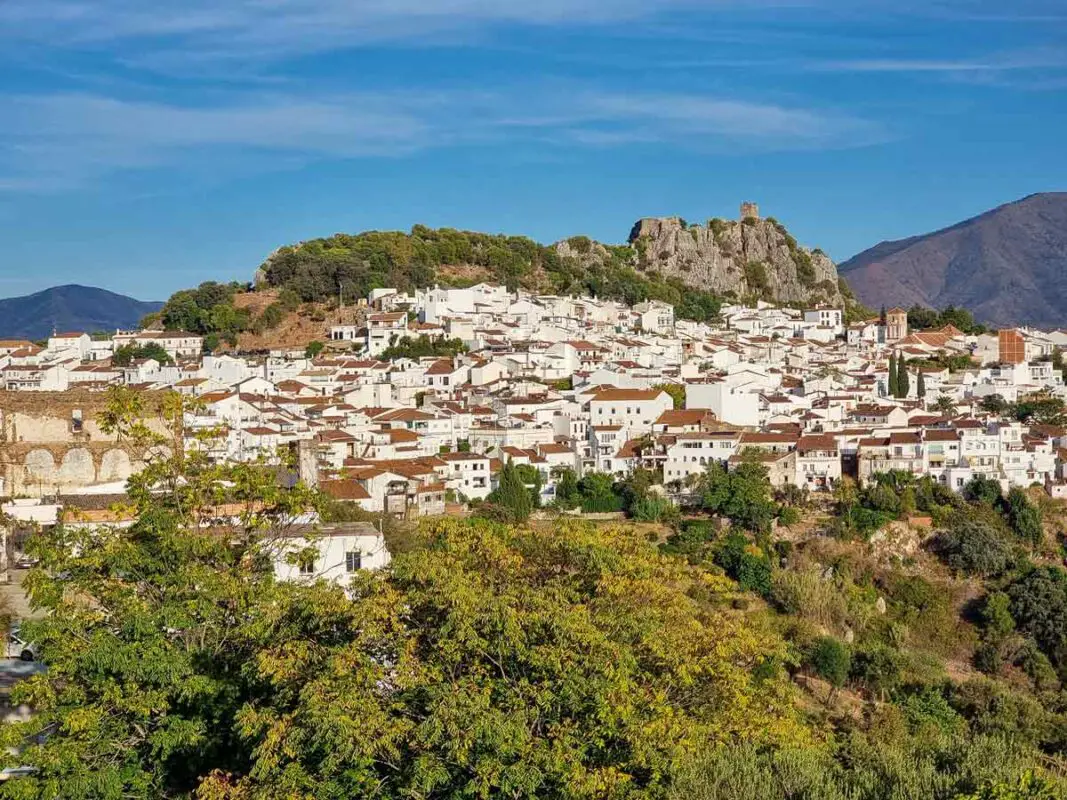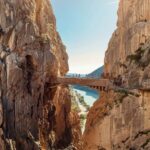My most recent road trip found me exploring some of the most beautiful white villages near Malaga. Whilst Gaucin wasn’t really on my list of places to see, I found myself booking a hotel for the night here. And good that I did, because turns out that Gaucin is extremely picturesque and it has almost no tourists at all. If you are looking to explore an authentic Andalucian white village, then Gaucin is the perfect choice. There are plenty of things to do in Gaucin, starting with visiting the Eagle Castle and continuing with plenty of other exciting things. Also, sunsets seen from the castle are pretty special. You have the entire scenery to yourself, from the mountain ranges all the way to the Mediterranean Sea. And, if you are lucky, you might even spot Gibraltar on a clear day.
I only had half a day to explore Gaucin, which was enough, as the village is very small.
Where to Stay in Gaucin

One thing that you probably know about me is that I don’t like driving in small villages, on narrow roads. So I always research accommodation options that are very close or on the main road. This is how I found Hostal Moncanda, a basic, very affordable B&B, just at the entrance to Gaucin. Plenty of parking spaces as well, with a cafe downstairs which was ideal for breakfast.
The room was basic but comfortable. I paid less than 35 euros a night and for that, it was perfect. You can click here to see the latest rates on Booking.com.
A Little Bit About Gaucin

This charming village, with less than 2,000 residents, is a haven for artists inspired by its natural beauty. Narrow medieval streets wind between whitewashed houses, sprawling across two hills and the valley between them.
At 626 meters above sea level, Gaucin overlooks the deep River Genal valley and is watched over by the impressive Sierra del Hacho mountain. The village’s name hints at its avian residents – it’s common to see eagles circling the castle towers and kestrels nesting in the convent walls.
The Best Things To Do In Gaucin
Visit Castillo del Aguila (Eagle Castle)

Perched atop the village, Castillo del Aguila is a the number one tourist attraction in Gaucin. This ancient fortress, dating back to Roman times, is a fascinating place to visit due to its tumultuous history. As you explore the castle grounds, you’ll encounter remnants from various periods, including Roman, Visigothic, and Moorish influences. The castle’s strategic location made it a key defensive structure throughout the centuries, playing crucial roles in conflicts, from the Reconquista to the Peninsular War.

The highlight of visiting Castillo del Aguila is undoubtedly the panoramic views it offers. From its towers, you can enjoy breathtaking vistas of the surrounding mountains, the Mediterranean Sea, and on clear days, even the coast of Africa. Don’t miss the opportunity to climb to the highest point for the best photo opportunities. The castle also houses a small museum where you can learn more about its history and the region’s past.
Explore Ermita del Santo Niño

The Hermitage of the Holy Child, located within the Castillo del Aguila complex, is a small 18th-century religious building. Its location inside the castle grounds makes it a unique blend of military and religious architecture. The hermitage consists of a main nave covered by a vault, separated by semi-circular arches from a narrower nave. This architectural layout creates an intimate and serene atmosphere perfect for quiet reflection.
Inside the hermitage, you’ll find a wooden image from the 17th century that, according to local tradition, was brought from Ceuta. This image, an object of great worship in Gaucin, is said to have been brought to the village after an apparition of the Baby Jesus. The hermitage also houses a small chapel dedicated to San Juan de Dios, adding to its religious significance. Even if you’re not religious, the hermitage’s historical and cultural value makes it worth a visit.
See the Unique Cemetery

Gaucin’s cemetery, located just below the castle rocks, is pretty unique and I’ve only seen a similar one in Casares. Unlike typical cemeteries, the graves here are stacked in rows of four, creating a visually striking arrangement. This design is not only practical given the limited space in the mountainous terrain but also creates a sense of community even in death.
As you walk through the cemetery, you’ll notice that each grave has fresh flowers flowers. The peaceful atmosphere, combined with the backdrop of the castle and the surrounding mountains, makes this a surprisingly reflective spot. Remember to be respectful during your visit, as this is a burial ground for the local community and not a touristic attraction.
Check Out Iglesia de San Sebastian

The Church of San Sebastian, built in the early 16th century following the Christian conquest of Ronda in 1485, is a prime example of religious architecture in the region. Its construction marks an important period in Gaucin’s history, symbolizing the transition from Moorish to Christian rule. The church underwent significant remodeling in the 17th century, which gave it its current appearance and shape.
Inside the church, you’ll find a layout of three naves separated by thick pillars supporting semi-circular arches. The interior has a richly gilded three-body altarpiece, presided over by Saint Sebastian and an image of the Virgen de las Nieves, the patron saint of Gaucin. The church’s Renaissance façade is another highlight, featuring brick construction with columns and a triangular pediment. To the left, you’ll see the tower with its squared ground plan, which houses the bells.
Dine at La Taberna del Zorro

For dinner, I stumbled upon La Taberna del Zorro – the only open restaurant that evening. I couldn’t resit ordering the Presa Iberica, which is the best pork dish you can order in Spain. The Iberian pork steak was so tender, with meat that simply melted in my mouth. It came with a side of potatoes and roast vegetables, quite basic, to let the meat shine on the plate. It may not look that much, but I promise you, it was the best meal I had during this road trip. The steak was cooked to perfection.
Drink from Fuente de Los 6 Caños

Going back to my hotel, I stumbled upon the Fountain of the Six Spouts, where I filled my water bottle. The Fountain of the Six Spouts, is more than just a water source – it’s a piece of living history. Built in 1628, this Baroque Andalusian fountain has been quenching the thirst of locals and visitors for nearly four centuries.
Each of the six spouts is said to have a slightly different mineral composition, so take the time to taste from each one if you’re feeling adventurous. The fountain also serves as a popular meeting point for locals, so it’s a great place to pause, refresh yourself, and perhaps strike up a conversation with Gaucin residents. On this particular evening there was none around. It may have been a bit too late.
Take in the Views from Mirador El Asalto del Cura

Mirador El Asalto del Cura offers some of the most spectacular views in Gaucin. From this vantage point, you can take in panoramic photos of the castle and the surrounding mountains, and on clear days, even the Mediterranean Sea and the coast of Africa. During my trip, even though it was sunny, there was a haze in the air which restricted the view quite a bit.
For Adrenaline Junkies: Try the Via Ferrata

Whilst this is a big no-no for me as I hate heights, for those seeking an adrenaline rush, Gaucin’s via ferrata offers an exciting way to experience the area’s rugged landscape. A via ferrata, Italian for “iron path,” is a protected climbing route equipped with fixed cables, ladders, and bridges. Gaucin’s route allows climbers to scale the dramatic cliffs surrounding the village, providing a unique perspective on the landscape and an exhilarating physical challenge.
Before attempting the via ferrata, it’s crucial to ensure you have the proper equipment and, if you’re a beginner, to go with a guided group. Local adventure companies offer tours that provide all necessary gear and instruction. The route offers varying levels of difficulty, making it accessible to both novice and experienced climbers.
Gaucin had captured a piece of my heart in just a short afternoon, whilst I explored it in peace, without the hoards of tourists that other places are full of. As I drove away in the morning, watching the village recede in my rearview mirror, I knew it wasn’t goodbye, but rather, “hasta luego” – see you later.
For more similar articles, check out my recommendations below:
- The best things to do in Mijas Pueblo
- The best things to do in Casares
- The best things to do in Setenil de las Bodegas
Liked it? Pin it!

Disclaimer: Some of the links on this website are “affiliate links.” This means that if you click on the link and do a purchase, I will receive an affiliate commission at no extra cost to you. This helps me keep my website running and continue to share my travelling knowledge with you. I thank you for booking your flights or hotels using the links on my website. Regardless, I only recommend products or services I use personally and believe will add value to my readers.





